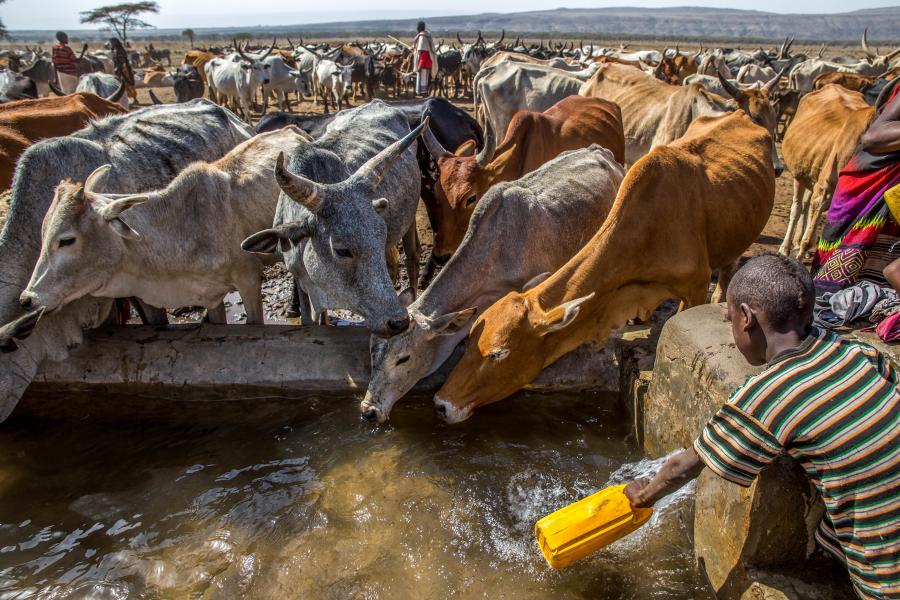The one-humped wonder: Ethiopia’s camels in focus

Camels in Metahara area, Mieso, Mirab Hararghe Zone of the Oromia Region, Ethiopia. Source
Photo: Apollo Habtamu (ILRI)
As the United Nations marks 2024 as the International Year of Camelids, we explore some key facts about Ethiopia’s camels, and their crucial but underappreciated role in supporting livelihoods and food security in the face of climate change.
By Prof Bekele Megersa, Prof Kebede Amenu, Dr Theo Knight–Jones and Prof Wudu T Jemberu
For thousands of years, humans have relied on camels thanks to their ability to adapt to extreme environmental conditions. They can survive and produce milk, meat and fibre during droughts, famines and conflict. They are critical for food security and livelihoods in numerous regions of the world and specifically play important roles for marginalised pastoralist communities living in arid environments. But significant data gaps and low investment have led to camels being neglected in research and development initiatives in Ethiopia and across the Horn of Africa.
Camel population trends
The one humped dromedary camel is the dominant species, making up about 90% of the global camel population with a wide distribution in the arid areas of Near East, Middle East, South Asia and Africa (Faye, 2020). The Horn of Africa is the camel hub of the world, hosting about 62% of the estimated 35.5 million heads of dromedary camels worldwide. With an estimated 7 million camels, Ethiopia has one of the largest camel populations of all countries. The camel population in Ethiopia has grown rapidly in the last few decades, at a rate of 4.5% per year, and this growth is the second fastest of all livestock species in Ethiopia after goats (Figure 1).

Camel herding is also expanding amongst Ethiopia’s traditionally cattle herding pastoralists, such as in Borana and South Omo zones. This expansion is driven by camels coping better with increasingly common and severe droughts. They are also less associated with advancing rangeland degradation and bush encroachment. This increasing trend of camel herding has also been seen in parts of Sub-Saharan Africa, including Northern Kenya and Central Kenya, and the Sahel.
Camels, livelihoods and climate resilience

As well as being more drought resilient, camels produce three times less methane than cattle (PDF) for the same quantity and quality feed. Hence camels can be used both as a means of climate change adaptation and mitigation, suited for climate smart farming.
Camels in Ethiopia produce about 1.4 billion litres of milk contributing to 25% of national milk production. Despite only accounting for 12% of livestock in Ethiopia, the overall production output value of camels in Ethiopia is estimated at USD 4.86 billion (excluding draft power value) contributing about 24% of the USD19 billion combined production output value of Ethiopian cattle, small ruminants and camels.
Investing in camels for the future
Despite their importance and potential, camels remain neglected in research and development initiatives in Ethiopia and across the Horn of Africa. Investment in camel production is also limited. This is partly because camels are not considered a global priority in livestock research. Camels make up less than 1% of the world's herbivore livestock and are primarily raised in low-income countries. Generally, there is limited data available to make evidence-based decisions around camel production. Extension services on improved camel husbandry is non-existent. Camel diseases are often poorly investigated and understood, yet disease outbreaks (PDF) can cause huge socioeconomic crises in camel herding communities across the Horn of Africa.
Considering the regional importance of camels, greater investment is urgently needed to unlock the unrealised potential that camels have for improving livelihoods and food security in the face of climate change.
Further Reading:
- Ethiopian Livestock Statistics 2021/22 - Ethiopian Statistics Service
- Role of Camel Breeding in the Third Millennium Economies by B. Faye (2015)
- How Many Large Camelids in the World? by B. Faye (2020)
- Climate Change and Camel Farming Systems by B. Faye et al. (2012)
- Camel Sudden Death Syndrome (PDF) - USAID Technical Brief
- Methane Production in Camels vs. Cattle (PDF) by A. Guerouali and F. Laabouri (2018)
- Small Ruminants in Ethiopia by W.T. Jemberu et al. (2022)
- Ethiopian Cattle Production Systems by Y. Li et al. (2023)
- Climate Change Impacts on Cattle Production in Southern Ethiopia by B. Megersa et al. (2014)
- Camel Production Systems in Ethiopia by T. Mirkena et al. (2018)
About the authors
Prof Bekele Megersa is Head of the Department of Microbiology, Immunology, and Veterinary Public Health at the College of Veterinary Medicine, Addis Ababa University. Dr. Theo Knight-Jones and Prof Wudu Jemberu are both Veterinary Epidemiologists at the International Livestock Research Institute (ILRI) and together implement the Ethiopia country study within the Global Burden of Animal Diseases (GBADs) programme. Prof Kebede Amenu is specialist in food safety and tropical animal health, contributing to GBADs disease prioritization theme.


